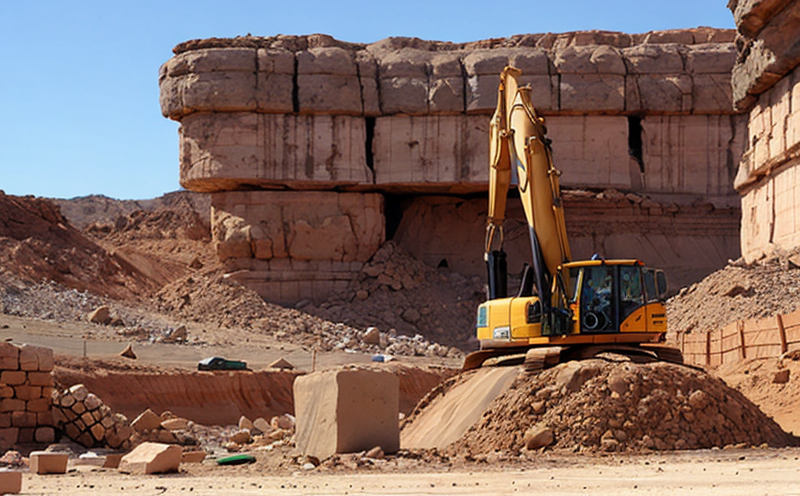ISO 17892 Part 10 Direct Shear Strength Testing
The ISO 17892-10 standard provides a comprehensive framework for direct shear strength testing of rocks, which is essential for assessing the stability and behavior of rock masses under various loading conditions. This test method is particularly valuable in mining applications where understanding the mechanical properties of rocks can significantly influence operational safety and efficiency.
In the context of mining, direct shear tests are used to evaluate the strength and deformation characteristics of rock samples subjected to shear stress. These tests help predict how rocks will behave under conditions similar to those encountered during excavation or tunneling operations. The test involves placing a specimen in a shearing box, applying a normal load, and then gradually increasing the shear stress until failure occurs.
The direct shear test is one of several key tests conducted within the broader scope of geotechnical and rock mechanics testing. It provides insights into the inherent stability of excavations, particularly when dealing with complex geological formations such as fractured rocks or those containing significant amounts of clay minerals. By understanding these properties, mining engineers can better design support systems and implement strategies to mitigate risks associated with slope failures or ground subsidence.
The standard specifies detailed procedures for preparing specimens, applying loads, measuring displacements, and determining failure criteria. Compliance with ISO 17892-10 ensures consistency and reliability across different laboratories conducting similar tests, which is crucial given the variability inherent in natural rock materials. The method has been widely adopted globally due to its robustness and ability to yield meaningful data relevant for both research purposes and practical applications.
Real-world usage of this test often involves comparing results obtained from core samples taken directly from potential excavation sites with laboratory test outcomes derived using standardized procedures like those outlined in ISO 17892-10. Such comparisons allow for more accurate assessments of rock quality, enabling informed decisions regarding appropriate excavation techniques and support structures needed to ensure safe operations.
It is important to note that while the direct shear test offers valuable information about a rock's resistance to shearing forces, it does not capture all aspects affecting overall stability. For instance, factors such as joint orientations, water content, temperature changes, and chemical weathering processes can also play significant roles in determining long-term performance of an excavation. Therefore, when interpreting results from direct shear tests, these additional variables must be considered alongside the quantitative data provided by the test itself.
The application of ISO 17892-10 extends beyond mere compliance; it serves as a tool for improving mining practices through enhanced decision-making processes. By providing consistent and reliable measurement techniques, this standard supports efforts aimed at minimizing risks associated with rockfalls or other geological hazards within mining environments.
For quality managers responsible for ensuring product integrity across various stages of production, compliance with standards such as ISO 17892-10 represents a fundamental aspect of their role. They can leverage the detailed procedures specified in this document to establish robust testing protocols that align with industry best practices.
Similarly, compliance officers play a critical part in maintaining regulatory adherence within organizations operating under stringent environmental regulations. Adherence to ISO 17892-10 helps ensure that all relevant tests are conducted accurately and consistently, thereby supporting efforts aimed at reducing potential liabilities related to non-compliance.
R&D engineers benefit from the standardized approach provided by this standard as it allows them to compare their experimental findings with those reported in peer-reviewed literature or other reputable sources. This facilitates knowledge sharing within the broader scientific community while fostering innovation through continuous improvement of existing methods and development of new approaches tailored specifically towards addressing unique challenges faced by different industries.
Lastly, procurement professionals can utilize ISO 17892-10 when specifying requirements for suppliers involved in providing equipment or services related to geotechnical testing. Ensuring that all parties adhere to the same set of guidelines promotes fairness and transparency throughout supply chain operations, ultimately leading to higher quality outcomes.
In summary, ISO 17892-10 plays a pivotal role in enhancing safety, efficiency, and sustainability within mining operations by offering reliable means for evaluating rock mechanics properties. Its widespread acceptance reflects its importance not only among technical experts but also across multiple stakeholder groups involved in maintaining high standards of practice.
Applied Standards
The ISO 17892-10 standard is designed to complement other international standards such as ASTM D5467, EN 12370, and the British Standard BS 5936. These complementary documents provide additional guidance on related topics like sample preparation, testing procedures, and interpretation of results.
Compliance with ISO 17892-10 ensures consistency in methodology across different laboratories worldwide, which is crucial given the variability inherent in natural rock materials. The standard specifies detailed procedures for preparing specimens, applying loads, measuring displacements, and determining failure criteria.
International Acceptance and Recognition
The ISO 17892-10 standard has gained significant recognition globally due to its robustness and ability to yield meaningful data relevant for both research purposes and practical applications. Its widespread adoption reflects the importance placed on ensuring accurate and reliable measurements within the mining industry.
Many countries have incorporated elements of ISO 17892-10 into their national standards or guidelines, further emphasizing its relevance and applicability in diverse environments. For instance, Australia's AS/NZS 4653:2009 includes references to this standard for direct shear testing.
Competitive Advantage and Market Impact
Adherence to ISO 17892-10 provides mining companies with several competitive advantages. Firstly, it enhances reputation by demonstrating commitment to high-quality practices aligned with international standards. Secondly, compliance ensures consistency in testing results across different laboratories, fostering trust among stakeholders.
Moreover, organizations that adopt these methods early on may gain a strategic advantage over competitors who lag behind in adopting similar best practices. By staying ahead of regulatory changes and technological advancements, mining firms can position themselves as leaders in their respective markets.





